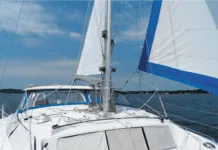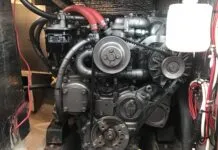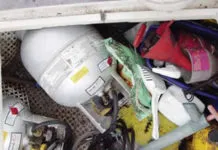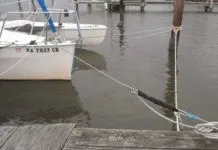The Penny-Pinching PhD Sailor
A key principle, at least from my perspective as an engineer, is knowing your boat. In 30 years of boat ownership, Ive only used contractor services for major sail work, new canvas (only because Ive never taken the time to learn), and hauling out. As a result, I know my boat inside out; thats a good feeling, an important part of seamanship, a blessing when something goes bust on a cruise, and a big help when time is available but funds are thin.
Meek Cleaner vs. Chemical Beast
In the November 2007 issue, we reviewed a big batch of waterline stain removers/hull cleaners. Spray Nines gel got the nod over the 21 other products, but there were a number of Excellent results-and thats because these acid-based cleaners don't mess around. One of the most aggressive cleaners out there is the MaryKate On&Off, which received an Excellent rating and was a Recommended product. Made by CRC Industries, it is a caustic stew of acids, mostly hydrochloric (20 to 25 percent by weight) and phosphoric (5 to 10 percent), with a bit of oxalic (1 to 5 percent). Weve used it often, with good results, but it only would be considered pleasant if youre nostalgic for World War I trench warfare. Even outside in a breeze, it stings the eyes, nose, and breathing passages. If you work without a respirator-not recommended, but sometimes done-you need to hold your breath when in range of the fumes, and take new breaths upwind. (Its best to wear a respirator, rubber gloves, and eye protection.)
Where Credit Is Due: May 2014
While my wife and I have given up sailing, our current boat, a 1998 Eastbay 38, is equipped with a Maxwell Freedom 800 windlass. When preparing the boat for launch this year, I noticed that the sight glass had been splintered. Likely due to a previously broken seal that allowed water into the gearbox and the water freezing during one of the coldest winters in Connecticut in years.
Where Credit is Due: January 2013
I wanted to send PS an update regarding the Dutchman Boom Brake recall that PS announced in the May 2012 issue. First of all, Dutchman Sail Hardware (www.mvbinfo.com) is standing behind its product 100 percent and going beyond normal warranty.
Will Your Tanks Be Clean Next Spring?
When contributor Drew Frye commissioned his familys PDQ 32 catamaran six years ago, his daughter asked, What are these pink lumps in the sink, Dad? The toilet bowl was even more spectacular, a science project in a dozen hues of pink, green, yellow, and black. The boat had been winterized for some time, down in south Chesapeake Bay, where winters are mild and many boaters and don't take freezing seriously.
Where Have All the Bearded Sailors Gone?
Careful readers of Practical Sailor may note an obvious shortage of grumpy old men scratching their heads over sailing gear in this months issue. We have contributing editor David Gill brewing a variety of cleaning acids on page 27 ("Boat Bath"), but most of the articles are illustrated primarily with photos of boats, sailing gear, and perhaps most notably, women. In John Spiers power tools report on page 31, we have his wife, Kerri Spier, aloft and handling one of his recommended cordless tools, a Makita angle drill. And in our analysis of the new Torqeedo electric outboard on page 18, we have Associate Editor Ann Key enduring a South Florida bake-athon and waiting for the battery to peter out. And in our test of remote microphones on page 13, instead of the familiar mug of our electronics guru Al Herum, we have his more photogenic girlfriend, Patti Schrader demonstrating the function of the Standard Horizon unit.
Mailport: October 2011
Letters to Practical Sailor, October 2011. This month's letters cover subjects such as: DIY Dingy Wheels, Infant PFD Field Test Phone Foulies, and More!
YouTube Sailing: Eight Videos Packed with Practical Knowledge
Editor's note: Practical Sailor entered the YouTube world in earnest a year ago, led by Editor-in-Chief Tim Labute, and the channel now has over...
Controlling Motion: Two Case Studies
Securing a small boat between pilings in a wrong-sized slip is a common challenge. The dock line angles from the dolphins (outlying pilings) are too narrow for a beam wind, allowing the boat to dance around, increasing forces, chafe, and even making it difficult to stand in the cockpit. During a recent winter near-gale we measured dockline forces on several smaller boats that reached four times higher than the static wind load. If the recommended size dockline was used, the rope would be operating beyond its working load limit in real storms and could fail. Increasing the line diameter would result in more jerking and chafe.
Two-Part Varnishes Take the Spotlight in Practical Sailors Exterior Wood Coatings Test
The two-part varnish test launch is the third installment of an ongoing report on our marine exterior wood coatings test, which began with an introduction to one-part varnishes (August 2007), followed by our synthetics and wood stains review (October 2007). The two-part teak coatings being tested are the Bristol Finish Traditional Amber, Smith & Co.s Five-Year Clear, HMG Paints Acrythane XSC, Interluxs Perfection, and Bonstones Nautiking NautiThane.













































